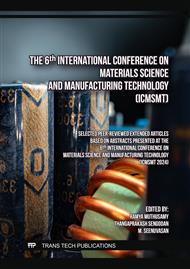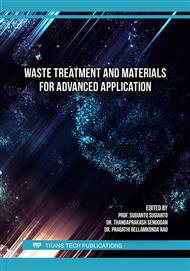[1]
R. J. Cava, "Dielectric materials for applications in microwave communications," J. Mater. Chem., vol. 11, no. 1, p.54–62, 2001.
DOI: 10.1039/b003681l
Google Scholar
[2]
R. Ubic, G. Subodh, and M. T. Sebastian, "High Permittivity Materials," in Microwave Materials and Applications, First Ed.John Wiley & Sons, Ltd., 2017, p.149–202.
DOI: 10.1002/9781119208549.ch4
Google Scholar
[3]
P. V. Bijumon, M. T. Sebastian, and P. Mohanan, "Experimental investigations and three-dimensional transmission line matrix simulation of Ca 5-x A x B 2 Ti O 12 (A=Mg, Zn, Ni, and Co; B=Nb and Ta) ceramic resonators," J. Appl. Phys., vol. 98, no. 12, 2005.
DOI: 10.1063/1.2149187
Google Scholar
[4]
R. D. Richtmyer, "Dielectric resonators," J. Appl. Phys., vol. 10, no. 6, p.391–398, 1939.
DOI: 10.1063/1.1707320
Google Scholar
[5]
R. D. Raytheon, "A new low-loss high-K temperature- compensated dielectric for schottky-gate bulk effect digital," Proc. IEEE, vol. 59, no. 11, p.1628–1629, 1971.
DOI: 10.1109/PROC.1971.8508
Google Scholar
[6]
J. K. Plourde, D. F. Linn, H. M. O'Bryan, and J. Thomson, "Ba2Ti9O20 as a Microwave Dielectric Resonator," J. Am. Ceram. Soc., vol. 58, no. 9–10, p.418–420, 1975.
DOI: 10.1111/j.1151-2916.1975.tb19013.x
Google Scholar
[7]
S. J. Fiedziuszko and S. Holme, "Dielectric resonators raise your high-Q," IEEE Microw. Mag., vol. 2, no. 3, p.51–60, 2001.
DOI: 10.1109/6668.951549
Google Scholar
[8]
S. Parida, S. K. Rout, V. Subramanian, P. K. Barhai, N. Gupta, and V. R. Gupta, "Structural, microwave dielectric properties and dielectric resonator antenna studies of Sr(Zr xTi 1-x)O 3 ceramics," J. Alloys Compd., vol. 528, p.126–134, 2012.
DOI: 10.1016/j.jallcom.2012.03.047
Google Scholar
[9]
J. H. Paik, C. H. Choi, S. Nahm, J. D. Byun, and H. J. Lee, "Structural and microwave dielectric properties of La(Mg2/3Nb1/3)O3 ceramics," J. Mater. Sci. Lett., vol. 18, no. 11, p.889–894, 1999.
DOI: 10.1023/A:1006660613457
Google Scholar
[10]
S. S. Rajput, S. Keshri, V. R. Gupta, N. Gupta, V. Bovtun, and J. Petzelt, "Design of microwave dielectric resonator antenna using MZTO-CSTO composite," Ceram. Int., vol. 38, no. 3, p.2355–2362, 2012.
DOI: 10.1016/j.ceramint.2011.10.088
Google Scholar
[11]
S. George and M. T. Sebastian, "Microwave dielectric properties of novel temperature stable high Q Li2Mg1-xZnxTi3O8 and Li2A1-xCaxTi3O8 (A=Mg, Zn) ceramics," Journal of the European Ceramic Society, vol. 30, no. 12. p.2585–2592, 2010.
DOI: 10.1016/j.jeurceramsoc.2010.05.010
Google Scholar
[12]
Z. Zhang et al., "High-Q and near-zero τf composite Li2Mg2TiO5-Sr3(VO4)2 ceramics for low-temperature co-fired ceramic applications," Ceram. Int., vol. 46, no. 6, p.8281–8286, 2020.
DOI: 10.1016/j.ceramint.2019.12.057
Google Scholar
[13]
S. S. Rajput, S. Keshri, and V. R. Gupta, "Microwave dielectric properties of (1-x)Mg0.95Zn 0.05TiO3-(x)Ca0.6La0.8/3TiO 3 ceramic composites," J. Alloys Compd., vol. 552, p.219–226, 2013.
DOI: 10.1016/j.jallcom.2012.10.019
Google Scholar
[14]
Y. Ji, K. Song, X. Luo, B. Liu, H. Barzegar Bafrooei, and D. Wang, "Microwave Dielectric Properties of (1-x) Li2MoO4–xMg2SiO4 Composite Ceramics Fabricated by Cold Sintering Process," Front. Mater., vol. 6, no. October, p.1–6, 2019.
DOI: 10.3389/fmats.2019.00256
Google Scholar
[15]
H. Zhou, X. Tan, X. Chen, and H. Ruan, "Effect of raw materials pretreated by physical grinding method on the sintering ability and microwave dielectric properties of Li2MgTiO4 ceramics," J. Alloys Compd., vol. 731, p.839–843, 2018.
DOI: 10.1016/j.jallcom.2017.10.114
Google Scholar
[16]
Z. Fu, P. Liu, J. Ma, X. Chen, and H. Zhang, "New high Q low-fired Li2Mg3TiO6 microwave dielectric ceramics with rock salt structure," Mater. Lett., vol. 164, p.436–439, 2016.
DOI: 10.1016/j.matlet.2015.11.046
Google Scholar
[17]
J. Li et al., "Crystal structure and microwave dielectric properties of a novel rock-salt type Li3MgNbO5 ceramic," J. Mater. Sci., vol. 55, no. 33, p.15643–15652, 2020.
DOI: 10.1007/s10853-020-05141-0
Google Scholar
[18]
C. Li, C. Yin, M. Deng, L. Shu, and J. Khaliq, "Tunable microwave dielectric properties in SrO-V2O5 system through compositional modulation," J. Am. Ceram. Soc., vol. 103, no. 4, p.2315–2321, 2020.
DOI: 10.1111/jace.16955
Google Scholar
[19]
R. Umemura, H. Ogawa, H. Ohsato, A. Kan, and A. Yokoi, "Microwave dielectric properties of low-temperature sintered Mg3(VO4)2 ceramic," J. Eur. Ceram. Soc., vol. 25, no. 12 SPEC. ISS., p.2865–2870, 2005.
DOI: 10.1016/j.jeurceramsoc.2005.03.156
Google Scholar
[20]
P. Yao, Y. Deng, and B. Li, "Sintering characteristic, microstructure and microwave dielectric properties of the borax-added Sr3(VO4)2 ceramics," Ceram. Int., vol. 47, no. 2, p.2202–2207, 2021.
DOI: 10.1016/j.ceramint.2020.09.059
Google Scholar
[21]
H.M. Rietveld, "A profile refinement method for nuclear and magnetic structures," J. Appl. Crystallogr., vol. 2, no. 2, p.65–71, 1969.
DOI: 10.1107/s0021889869006558
Google Scholar
[22]
L.B. Mccusker, R.B. Von Dreele, D.E. Cox, D. Louër, and P. Scardi, "Rietveld refinement guidelines," J. Appl. Crystallogr., vol. 32, no. 1, p.36–50, 1999.
DOI: 10.1107/S0021889898009856
Google Scholar
[23]
B.W. Hakki and P.D. Coleman, "A Dielectric Resonator Method of Measuring Inductive Capacities in the Millimeter range," IRE Trans. Microw. Theory Tech., vol. 80, no. MTT 8, p.402–410, 1960.
DOI: 10.1109/TMTT.1960.1124749
Google Scholar
[24]
W.E. Courtney, "Analysis and Evaluation of a Method of Measuring the Complex Permittivity and Permeability of Microwave Insulators," IEEE Trans. Microw. Theory Tech., vol. 18, no. 8, p.476–485, 1970.
DOI: 10.1109/TMTT.1970.1127271
Google Scholar
[25]
S.B. Cohn and K.C. Kelly, "Microwave Measurement of High-Dielectric-Constant Materials," IEEE Trans. Microw. Theory Tech., vol. 14, no. 9, p.406–410, 1966.
DOI: 10.1109/TMTT.1966.1126288
Google Scholar
[26]
Y. Kobayashi and M. Katoh, "Microwave Measurement of Dielectric Properties of Low-Loss Materials By the Dielectric Rod Resonator Method.," IEEE Trans. Microw. Theory Tech., vol. MTT-33, no. 7, p.586–592, 1985.
DOI: 10.1109/tmtt.1985.1133033
Google Scholar
[27]
M. A. Dinesh, V. Kumar, R. Kumar, V. R. Gupta, V. Subramanian, and V. Dayal, "Investigating a Cylindrical Dielectric Resonator Antenna Fabricated with Li 3 MgNbO 5 Microwave Dielectric Ceramic," ECS J. Solid State Sci. Technol., vol. 13, no. 5, p.53003, 2024.
DOI: 10.1149/2162-8777/ad4239
Google Scholar
[28]
A.D. Prasetya, M. Rifai, Mujamilah, and H. Miyamoto, "X-ray diffraction (XRD) profile analysis of pure ECAP-annealing Nickel samples," J. Phys. Conf. Ser., vol. 1436, no. 1, p.012113, 2020.
DOI: 10.1088/1742-6596/1436/1/012113
Google Scholar
[29]
D.L. Wood and J. Tauc, "Weak Absorption Tails in Amorphous Semiconductors," Phys. Rev. B, vol. 5, no. 8, p.3144–3151, 1972.
DOI: 10.1103/PhysRevB.5.3144
Google Scholar
[30]
K. Darko and K. D. P. Guillon, Dielectric Resonators Second Edition. 1998.
Google Scholar
[31]
A. Petosa, A. Ittipiboon, Y. M. M. Antar, D. Roscoe, and M. Cuhaci, "Recent Advances in Dielectric-Resonator Antenna Technology," IEEE Antennas Propag. Mag., vol. 40, no. 3, p.35–47, 1998.
DOI: 10.1109/74.706069
Google Scholar



